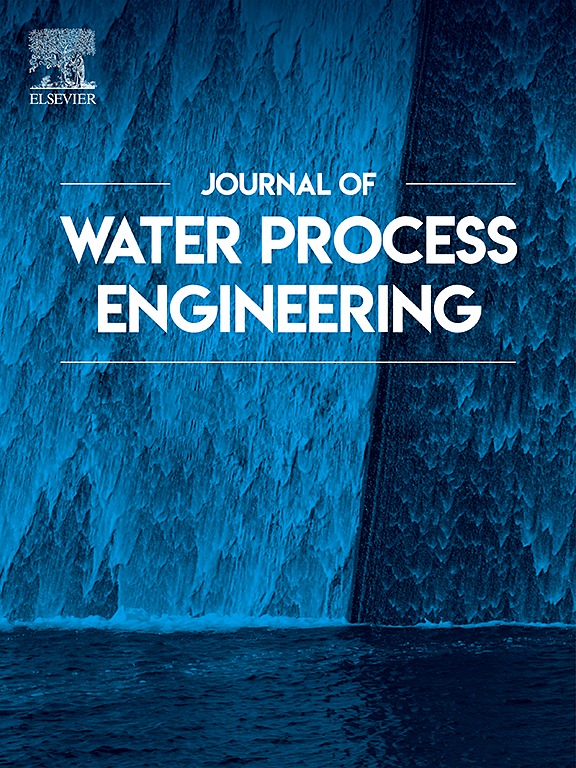最大化电子垃圾渗滤液吸附:多组分等温线模型和机制与可扩展介孔甘蔗甘蔗渣衍生的生物炭
IF 6.3
2区 工程技术
Q1 ENGINEERING, CHEMICAL
引用次数: 0
摘要
重金属污染是一个主要的环境和健康问题,会造成器官损伤、神经紊乱和发育问题。吸附法是一种从污染水中去除重金属的高效、经济的方法。采用扩展Langmuir (EL)、扩展Freundlich (EF)、修饰竞争型Langmuir (MCL)和扩展Sips (ES)等多组分等温线模型,研究了五种金属(Cu2+、Ni2+、Pb2+、Ag+和Mn2+)在介孔蔗渣衍生生物炭(表面积:1061.77 m2 g−1)上的吸附。通过KOH活化(1,1 w/w)合成生物炭,并在800℃下热解。发现ES模型最能描述竞争吸附行为。其中Pb2+的吸附量最大(605.45 mg/g),其次是Cu2+ (501.77 mg/g)。准一级和准二级模型的动力学分析证实了化学吸附的优势,特别是对Cu2+, Mn2+和Pb2+。限速步骤与温度有关;在25℃时以颗粒内扩散为主,而在55℃时以化学吸附为主。热力学分析(ΔH >;0, ΔG <;0)证实在测试条件下吸附过程是吸热自发的。经过三次再生循环,证实了生物炭结构的稳定性,并充分去除了吸附质的证据。本文章由计算机程序翻译,如有差异,请以英文原文为准。
Maximising E-waste leachate adsorption: multi-component isotherm models and mechanisms with scalable mesoporous sugarcane bagasse-derived biochar
Heavy metal contamination is a primary environmental and health concern contributing to organ damage, neurological disorders and developmental issues. Adsorption is an efficient, cost-effective method for removing heavy metals from contaminated water. In this study, the adsorption of five metals (Cu2+, Ni2+, Pb2+, Ag+ and Mn2+) into mesoporous sugarcane bagasse-derived biochar (surface area: 1061.77 m2 g−1) was investigated using multi-component isotherm models, including Extended Langmuir (EL), Extended Freundlich (EF), Modified Competitive Langmuir (MCL) and Extended Sips (ES). The biochar was synthesised via KOH activation (1, 1 w/w) followed by pyrolysis at 800 °C. The ES model was found to best describe the competitive adsorption behaviour. Among the tested metals, Pb2+ exhibited the highest adsorption capacity (605.45 mg/g), followed by Cu2+ (501.77 mg/g). Kinetic analysis using pseudo-first-order and pseudo-second-order models confirmed chemisorption superiority, specifically for Cu2+, Mn2+, and Pb2+. The rate-limiting step was temperature-dependent; intraparticle diffusion dominated at 25 °C, while chemisorption prevailed at 55 °C. The thermodynamic analysis (ΔH > 0, ΔG < 0) confirmed that the adsorption process is endothermic and spontaneous under the tested conditions. After three regeneration cycles, the biochar structure stability is confirmed with evidence of full adsorbate removal.
求助全文
通过发布文献求助,成功后即可免费获取论文全文。
去求助
来源期刊

Journal of water process engineering
Biochemistry, Genetics and Molecular Biology-Biotechnology
CiteScore
10.70
自引率
8.60%
发文量
846
审稿时长
24 days
期刊介绍:
The Journal of Water Process Engineering aims to publish refereed, high-quality research papers with significant novelty and impact in all areas of the engineering of water and wastewater processing . Papers on advanced and novel treatment processes and technologies are particularly welcome. The Journal considers papers in areas such as nanotechnology and biotechnology applications in water, novel oxidation and separation processes, membrane processes (except those for desalination) , catalytic processes for the removal of water contaminants, sustainable processes, water reuse and recycling, water use and wastewater minimization, integrated/hybrid technology, process modeling of water treatment and novel treatment processes. Submissions on the subject of adsorbents, including standard measurements of adsorption kinetics and equilibrium will only be considered if there is a genuine case for novelty and contribution, for example highly novel, sustainable adsorbents and their use: papers on activated carbon-type materials derived from natural matter, or surfactant-modified clays and related minerals, would not fulfil this criterion. The Journal particularly welcomes contributions involving environmentally, economically and socially sustainable technology for water treatment, including those which are energy-efficient, with minimal or no chemical consumption, and capable of water recycling and reuse that minimizes the direct disposal of wastewater to the aquatic environment. Papers that describe novel ideas for solving issues related to water quality and availability are also welcome, as are those that show the transfer of techniques from other disciplines. The Journal will consider papers dealing with processes for various water matrices including drinking water (except desalination), domestic, urban and industrial wastewaters, in addition to their residues. It is expected that the journal will be of particular relevance to chemical and process engineers working in the field. The Journal welcomes Full Text papers, Short Communications, State-of-the-Art Reviews and Letters to Editors and Case Studies
 求助内容:
求助内容: 应助结果提醒方式:
应助结果提醒方式:


